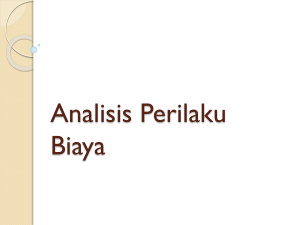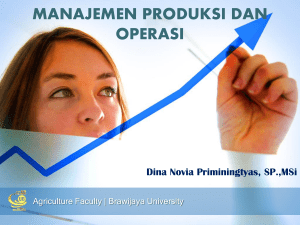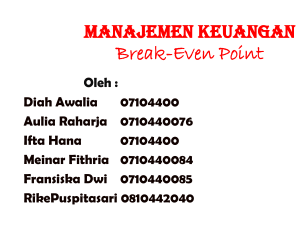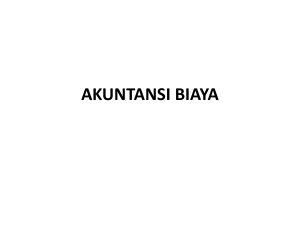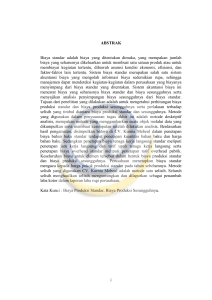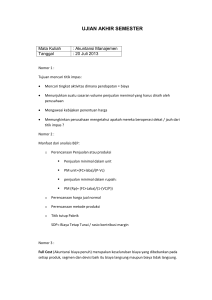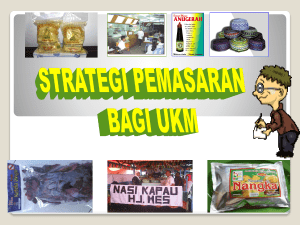Analisa Break Even Point
advertisement
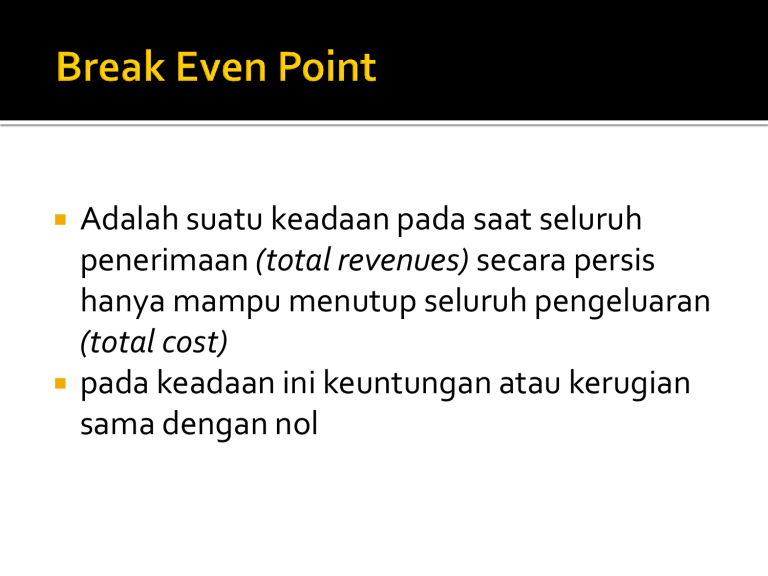
Adalah suatu keadaan pada saat seluruh penerimaan (total revenues) secara persis hanya mampu menutup seluruh pengeluaran (total cost) pada keadaan ini keuntungan atau kerugian sama dengan nol Hal tersebut dapat terjadi bila perusahaan dalam operasinya menggunakan biaya tetap, dan volume penjualan hanya cukup untuk menutup biaya tetap dan biaya variabel. Apabila penjualan hanya cukup untuk menutup biaya variabel dan sebagian biaya tetap, maka perusahaan menderita kerugian. Sebaliknya akan memperoleh memperoleh keuntungan, bila penjualan melebihi biaya variabel dan biaya tetap yang harus di keluarkan. Analisis Break even secara umum dapat memberikan informasi kepada pimpinan, bagaimana pola hubungan antara volume penjualan, cost/biaya, dan tingkat keuntungan yang akan diperoleh pada level penjualan tertentu. 1. 2. Jumlah penjualan minimal yang harus dipertahankan agar perusahaan tidak mengalami kerugian. Jumlah penjualan yang harus dicapai untuk memperoleh keuntungan tertentu. 3. 4. Seberapa jauhkah berkurangnya penjualan agar perusahaan tidak menderita rugi. Untuk mengetahui bagaimana efek perubahan harga jual, biaya dan volume penjualan terhadap keuntungan yang diperoleh. “Cost is the cash or cashequivalent value sacrificed for goods and services that is expected to bring a current or future benefit to the organization.”1 1Hansen & Mowen, 2007, p. 35. 6 ”Biaya (cost) adalah nilai kas atau ekuivalen kas yang digunakan untuk barang dan jasa yang diperkirakan untuk membawa manfaat di masa sekarang atau masa depan, pada organisasi”. Biaya Variabel Biaya Tetap Biaya Semivariabel Biaya variable Adalah biaya yang jumlah totalnya yang sebanding dengan perubahan volume kegiatan. Contoh biaya bahan baku, biaya tenaga kerja langsung. LO 3 Variable cost assumes a linear relationship between cost and activity driver. EXHIBIT 3-7 10 Biaya tetap Adalah biaya yang jumlah totalnya tetap dalam kisar volume kegiatan tertentu. Contoh : gaji direktur produksi. Total Fixed Cost Cost $1,500 Year 2 $1,000 Year 1 $500 Activity Level Biaya semivariable Adalah biaya yang berubah tidak sebanding dengan perubahan volume kegiatan. Biaya semifixed Adalah biaya yang tetap untuk tingkat volume kegiatan tertentu dan berubah dengan jumlah yang konstan pada volume produksi tertentu. Linearity Assumption Total Costs $Cost Fixed Costs Variable Costs Number of Units Produced Total Costs = Fixed Amount + Variable Cost Per Unit x Number of Units = Fixed Costs + Variable Costs Y = F + V(X) Y= Total mixed costs (the dependent variable) (X) = Cost Driver or Independent Variable LO 1 CVP expresses: # units that must be sold to break even Impact of a given reduction in fixed costs on break-even point Impact of an increase in price on profit Sensitivity analysis of impact of various price or cost levels on profit 15 LO 1 Is the point where total revenue equals total cost; the point of zero profit. 16 Harga jual tidak berubah-ubah Seluruh biaya dapat dibagi ke dalam biaya tetap dan biaya variabel Biaya variabel bersifat proporsional Jika barang yang diproduksi lebih dari satu jenis, maka komposisi barang yang dijual tidak berubah-ubah Revenue Total Revenues Profit Total Costs Y X X = Break-even point in units Y = Break-even point in sales revenue Units sold Fixed costs (F) = $40,000 Selling price per unit (P) = $10 Variable cost per unit (V) = $6 Tax rate = 40% 1. What is the break-even point in units? 2. What is the break-even point in dollars? Units Sold Approach 1. Let X = break even point in units R = TC PX = F + VX $10X = $40,000 + 6X $10X - $6X = $40,000 $4X = $40,000 X = 10,000 units Units Sold Approach (continued) 2. Break-even point in sales dollars is: 10,000 x $10 = $100,000 This can be shown with a variable-costing income statement: Variable Costing Income Statement Sales (10,000 x $10) $100,000 Less variable costs (10,000 x $6) $ 60,000 Contribution margin $ 40,000 Less fixed costs $ 40,000 Profit before taxes $ 0 Less income taxes $ 0 Profit after taxes $ 0 Sales Revenue Approach Alternative approach to solving break-even point in sales dollars: Let X equal break-even sales in dollars: R = TC X = F + VX X = $40,000 + .6X X - .6X = $40,000 .4X = $40,000 X = $100,000 NOTE: V is the variable cost percentage which equals : Variable cost per unit/Selling price per unit = 6/10 = 60% Operating Income Approach Contribution Approach Graphical Approach Profit + I = (P-V)X-F Slope = P-V Profit loss - break-even point in units UNITS $300,000 Profit Total Revenue BEP 200,000 Loss Variable Costs 100,000 0 Total Costs 100 200 400 600 Number of Ovens Sold Fixed Costs 800 Sales - Variable costs - Fixed Costs = Net Income Sales-Revenue Method: 100%(Sales)- 60%(Sales) - $70,000 =0 (at BEP) 0.4 (Sales) = $70,000 Sales = $175,000 Units-Sold Method: Let x = Number of microwaves at the breakeven point $500(x) - $300(x) - $70,000 = 0 (at BEP) $200 (x) = $70,000 x = 350 microwaves Sales-Revenue Method: BEP (Revenue$) = (Fixed Costs + Net Income)/ Contribution Ratio = $70,000 / 0.40 = $175,000 Units-Sold Method: BEP (Revenue Units) = (Fixed Costs + Net Income)/Contribution per microwave = $70,000/$200 per microwave = 350 units ...establishing prices ...analyzing the impact of volume on profits ...focusing on the impact of costs on profits ...analyzing the impact of mix of products on profits A number of limitation are commonly mentioned with respect to CVP analysis: 1. The analysis assumes a linear revenue function and a linear cost function. 2. The analysis assumes that price, total fixed costs, and unit variable costs can be accurately identified, and remain constant over the relevant range. 3. The analysis assumes that what is produced is sold. 4. For multiple-product analysis, the sales mix is assumed to be known. 5. The selling prices and costs are assumed to be known with certainty. Assume that a company has the following projected income statement: Revenues $100,000 Variable expenses (60,000) Contribution margin 40,000 Fixed expenses (30,000) Income before taxes $ 10,000 Break-even point in dollars (R): R = $30,000 / .4 = $75,000 Safety margin = $100,000 - $75,000 Safety margin = $25,000 DOL = $40,000 / $10,000 = 4.0 Now suppose that sales are 25% higher than projected. What is the percentage change in profits? Percentage change in profits = DOL x percentage change in sales = 4.0 x 25% = 100% Proof: Revenues Less variable expenses Contribution margin Less fixed expenses Income before taxes $125,000 (75,000) $ 50,000 (30,000) $ 20,000 Assume the following: Sales (400 Microwaves) Less: Variable Expenses Contribution Margin Less Fixed Expenses Net Income Total Per unit %of Sales $200,000 $500 100% 120,000 300 60 $ 80,000 $200 40% 70,000 $ 10,000 1. What is the Operating Leverage? 2. What is the Margin of Safety? Operating Leverage = Contribution margin/Net Income = $80,000/$10,000 Operating Leverage = Contribution Margin / Net Income = 8 (an indication of operating risk) = $80,000 / $10,000 % change in profits = Operating= leverage x Change sales 8 (an indication ofinoperating risk) = 8 x 10% increase in sales %change in profits = Operating leverage x Change in sales = 80% increase in profits = 8 x 10% increase in sales Margin of Safety = Targeted Revenue - Break-even Point = 80% increase in profits = $200,000 - $175,000 = $25,000 Margin of Safety = Targeted Revenue - Break-even Point = $200,000 - 175,000 = $25,000 Assume the following: Sales price per unit $15 Variable cost 5 Fixed costs (conventional)-$180,000 Fixed costs (ABC)-$80,000 Other Data: Cost Driver Unit Variable Costs Level of Cost Driver Set-ups $500 100 Inspections 50 600 1. What is the BEP under conventional analysis? 2. What is the BEP under ABC analysis? 3. What is the BEP if set-up cost could be reduced to $450 and inspection cost reduced to $40? 1. Break-even units (conventional analysis) BEP = $180,000/10 = 18,000 units 2. Break-even units (ABC analysis) BEP = = [$100,000 + (100 x $500) + (600 x $50)]/$10 18,000 units 3. BEP = = [$100,000 + (100 x $450) + (600 x $40)]/$10 16,900 units What implications does ABC have for improving performance? Perusahaan yang beroperasi pada kondisi BEP berarti perusahaan secara akuntansi mengalami kerugian, namun secara cash flow perusahaan masih mendapatkan sisa kas, selama penerimaan penghasilan masih bisa menutupi biaya variabel dan biaya tetap tunai. Biaya tetap tunai adalah biaya tetap yang dikeluarkan secara tunai seperti pembayaran gaji, biaya promosi, sewa gedung, dan biaya tetap tunai lainnya. SDP merupakan pedoman bagi manajemen untuk memutuskan apakah perusahaan diteruskan atau dihentikan Apabila penerimaan penjualan masih lebih tinggi dibanding SDP sebaiknya perusahaan tetap beroperasi Titik Tutup Pabrik Apabila penerimaan perusahaan tidak dapat menutupi biaya variabel dan biaya tetap tunai, maka perusahaan sudah harus ditutup SDP = Biaya tetap tunai/rasio kontribusi margin
